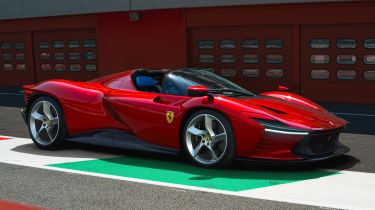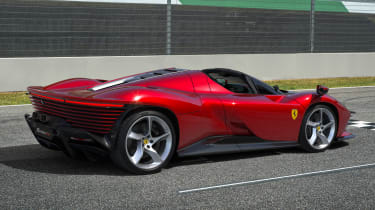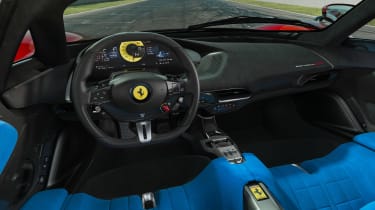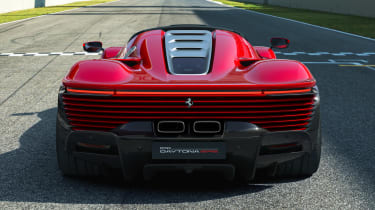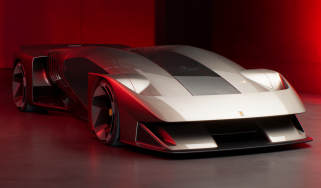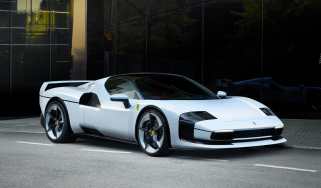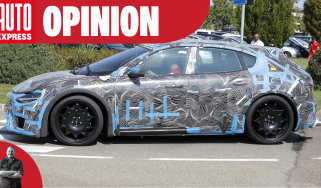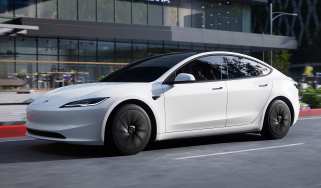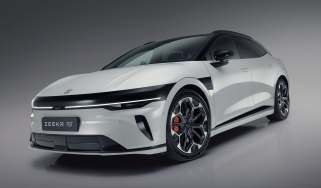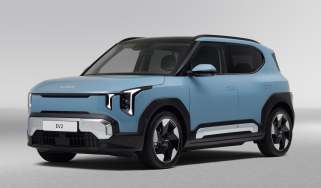New mid-engined Ferrari Daytona SP3 arrives with 829bhp V12
The new Ferrari Daytona SP3 is the latest model in the brand's Icona series, and is the first mid-engined V12 since the LaFerrari
Ferrari has never been a firm to shy away from its heritage - and its Icona series of models are designed to celebrate some of its most prestigious moments. The front-engined Monza SP1 and SP2 led the way, but now it’s time for the first mid-engined Icona: the Ferrari Daytona SP3.
The new creation is a tribute to one of Ferrari’s greatest ever days on the racetrack, when the firm locked out all three podium positions at the 1967 24 Hours of Daytona with a 330 P3/4, 330 P4 and 412 P. Presented at Ferrari’s traditional end-of-year bash at Mugello, the Daytona SP3 picks up the ‘mid-engined V12’ mantle last held by the company’s LaFerrari hypercar.
The new arrival also uses carbon-fibre construction, a technique that was also last used on the LaFerrari. Its body style is totally bespoke, though - and designed to mix cutting-edge aerodynamic efficiency with more than a few nods to sports prototype racers from the sixties.
Behind the wraparound windscreen, the cabin looks set into a dome, thanks to the pronounced curves of the front wings - a cue from the 512 S, 712 Can-Am and 312 P competition cars, Ferrari claims. The rear arches are even wider and more extreme, delivering muscular rear wings just ahead of the wheels, which then taper towards the rear.
Two other key features are the butterfly doors, which incorporate an airbox to channel air into the side-mounted radiators, and the removable targa roof - again, another hat-tip to sixties endurance racers. For the same reason, the side mirrors have been mounted on top of the front wheel arches.
At the rear, there’s a central ‘spine’ that runs down the middle of the bodywork, incorporating a clear panel to show some of the V12 engine. The ultra-slim tail-lights, meanwhile, are housed in a complex ‘multi-blade’ arrangement, which sits above a sophisticated diffuser and twin tailpipes. Overall, the shape delivers the greatest raw aerodynamic efficiency of any Ferrari - in ‘passive’ form, without any moving ‘active’ aero parts.
Instead of the LaFerrari’s electrically assisted 6.3-litre V12 powertrain, the Daytona SP3 uses a retuned version of the 812 Competizione’s 6.5-litre unit. The changes are significant enough for the motor to earn its own code; F140HC, instead of the F140HB designation used in the 812.
The engine uses titanium con rods, which are 40 per cent lighter than steel items, and a switch of material for the pistons. The crankshaft has been rebalanced and is three per cent lighter. These changes, and alterations to the air intake and exhaust system, help to make the engine the most powerful internal combustion motor ever fitted to a Ferrari. The total output is 829bhp (around 10bhp more than the 812) and 697Nm of torque, while the engine revs to 9,500rpm.
These raw numbers - and a retuned seven-speed dual-clutch gearbox that delivers faster shifts - help to take the 1,485kg (dry weight) Daytona SP3 from 0-62mph in 2.85 seconds, and from rest to 124mph in just 7.4 seconds. The top speed is “in excess of 211mph”, Ferrari says.
Inside, the cabin has further nods to competition cars; the blue upholstered seats are designed to echo the fabric of old-style racing buckets, and this material is used further on the door inserts to make the cabin feel wider. The seats themselves are integrated into the chassis and are therefore fixed; the pedal box moves instead.
The steering wheel features Ferrari’s familiar Manettino switch, which offers different driving modes that adjust a number of the car’s settings - including the profile of the Ferrari Dynamic Enhancer, the firm’s lateral dynamics control system.
Ferrari plans on producing 599 examples of the Daytona SP3; that’s 100 more than the total number of Monza SP1 and Sp2s that were made, and the increase is down to the fact that the Daytona will be homologated for road use worldwide. The car will cost two million euros in Italy, including local taxes, so UK customers should expect to spend just over £2m.
All 599 examples have already been allocated to clients, Ferrari says; the firm focused on existing Monza SP1 or SP2 owners, then a select list of potential customers in regions where those cars were not road legal, such as the United States. The first deliveries are expected before the end of 2022, and the production run will continue until 2024.
Q and A: Michael Leiters
Ferrari’s Chief Technology Officer Michael Leiters gives his view on the company’s latest Icona model, the Daytona SP3.
Q: Was this a particularly fast project?
A: We don’t talk specifics but we have already said that typically we have between 30 and 43 months to get to the start of commercial sales. This car is between those figures but closer to 30 than it is 43.
Q: The design team is said to have led the Daytona SP3 project. Did that approach give you any particular challenges?
A: The engine was quite difficult. To get to the power figure is difficult, in the engine itself but also from an integration point of view. It was quite challenging, without redoing all of the engine, obviously.
It’s making a lot of heat, and everything in the engine bay is very sophisticated and subtle. So if you look at the exhaust, the carbonfibre there is from F1, because that supports higher temperatures. We didn’t want to have a mesh there, where you could look through it and see tubes or whatever.
There’s also a little slot in the spoiler because we wanted to change the vortices there to suck out more heat from the engine bay.
Q: So you could have made a quicker car like this - in terms of lap times?
A: Yes. But this was not the aim. If I’d liked to have more performance, maybe I’d have stayed with the [LaFerrari] hybrid set-up.
Q: On that subject, is this series an opportunity to prolong the life of the Ferrari V12s?
A: I think so. It’s a good opportunity. It’s matching the customer requirements, and it has a limited impact on the discussion about CO2. But it’s not the only one. I personally believe that it’s important for Ferrari to fight for this engine. Obviously from a technological point of view it’s not the most efficient one - a V8 turbo could make better performance, for an example - but from an emotional point of view it’s the best you can have.
Q: How do you plan to compensate for the likely increase in weight when you launch your first pure-electric vehicle?
A: Weight is not the only point. There are many points we have to work on, for electrification. Software and controls, in general, is something that will probably help us to manage it. I think we reached with the SF90 a new level of control integration, and I think it’s a strength of Ferrari. Definitely we’ll continue to work on that. But Ferrari was always good on integration of different things physically and also like software, so I’m very positive that we will find a Ferrari solution.
Click here for more information on the Ferrari Monza SP1 and SP2...
Find a car with the experts

